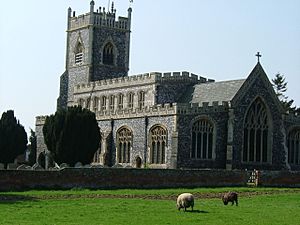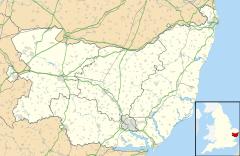Stratford St. Mary facts for kids
Quick facts for kids Stratford St. Mary |
|
|---|---|
 Stratford St Mary church in spring time |
|
| Population | 701 (2011) |
| District |
|
| Shire county | |
| Region | |
| Country | England |
| Sovereign state | United Kingdom |
| Post town | Colchester |
| Postcode district | CO7 |
| EU Parliament | East of England |
Stratford St. Mary is a lovely village located in Suffolk, England. It's right in the middle of what people call 'Constable Country'. This area is famous because the well-known artist John Constable painted many of his beautiful landscapes here, including scenes from Stratford itself.
The village of Stratford (which means "the ford of the Roman road") and its small nearby settlement, Higham, are found on the border between Suffolk and Essex. They sit right next to the River Stour. Stratford St. Mary is about 93 kilometers (58 miles) from London. You can find it just off the A12 road, between the towns of Colchester and Ipswich.
The village has a church built in the 1400s, made of a type of stone called flint. You can easily spot it from the A12 road. Stratford St. Mary also has a primary school, a post office, a village store, and three local pubs. The village is part of the Stratford Vale, which is a recognized area of outstanding natural beauty.
Contents
A Look Back in Time: Stratford's History
Stratford St. Mary has a very long history! People have lived here for thousands of years.
- Ancient Times: We know this because traces of a henge (a type of ancient circular monument, often made of earth or stones) from around 4,000 BC have been found. There are also signs of Roman settlements on a place called Gun Hill.
- Saxon Village: The first recorded village was a Saxon settlement mentioned in the Domesday Book of 1086. It had about 30 tenants (people who rented land) and a mill. This early village was later moved closer to the river and the main road to Bergholt as the community grew.
How the Wool Trade Made Stratford Rich
From 1318 onwards, old records from the local manor (a large estate) show that many families in Stratford were involved in the wool trade. This business brought a lot of wealth to the village early on.
- Wealthy Clothiers: Rich cloth makers, like the Mors (or Morse) family, gave a lot of money to help build and improve the church.
- Busy Coaching Days: Stratford's long main street, lined with inns (old hotels), shows how busy and important it was during the "coaching days." This was a time when people traveled by horse-drawn coaches. The village was a stopping point for a constant flow of cattle, turkeys, and geese being taken to sell in London.
How Many People Lived Here?
The national counts of people (censuses) from 1801 and 1901 show that just over 500 people lived in the Stratford St. Mary area during those times.
Exploring Historic Places in Stratford St. Mary
Stratford St. Mary is full of old buildings and interesting spots that tell stories from the past.
Old Houses and Their Stories
- Lowe Hill House: This is one of the most impressive old houses still standing. It was built around 1480. Even though it's a very old and grand house, it's probably not the very first manor house of the area.
- Ravenys: This house is so old that it was even painted by John Constable! His painting, called "a house in Water Lane," is now in the Victoria and Albert Museum. Records from 1442 show that the Lord of the Manor gave the land for this house to two men, William Smyth and William Wade, on the condition that they rebuild it. The lord even provided the main wooden beams for the new house.
- Gatemans: This house belonged to a weaver named Ralph Gateman in 1334. Today, it is the oldest house still standing in the village.
- Courtlands (formerly Thornes): The house now known as Courtlands was originally called Thornes. It was greatly expanded in the 1800s and later.
- Old Cage House (formerly Fyshers): This red-brick house was once called Fyshers. It got its current name from a "cage" or pound for stray animals that used to be on the site of the parish room cottage.
Inns and Travel Stops
- Three Coaching Inns: As more and more travelers passed through the village, three important inns grew up: The Anchor, The Swan, and the Black Horse.
- The Anchor: This inn had about 8 hectares (20 acres) of pasture land where cattle could rest overnight on their way to London.
- The Swan: This was a "posting-house," meaning it had lots of stables and rooms for travelers and their horses. It also provided lodging for temporary workers who followed the harvest season from south to north through East Anglia. Even King George II stayed here for a few hours in 1737!
- Goose Acre: This marshy piece of land next to the Corner House was used as an overnight pen for geese and turkeys traveling to London.
The River and Its Importance
- Fords: This is a beautiful timber (wooden) house with a meadow next to it, across from the Black Horse inn. It's close to a narrow strip of unused land that shows where the old London road used to be.
- Le Talbooth: This building was originally two cottages with their own quay (a landing place for boats) and a lime kiln (a furnace for making lime). Chalk was brought here by barge from Sudbury, and coal came from Manningtree and Mistley. It was first called the Tolbooth in 1659. Goods were weighed here, and tolls (fees) were collected to help maintain the tall, narrow toll bridge. The weirs (dams) and locks (water gates) on the river made the area likely to flood when the river level rose.
The Mors Family and the Old Mill
- Skalders: This was the home of the wealthy Mors family for 200 years. Thomas Mors was one of three rich cloth makers in the village and gave a lot of money to the church. His wife, Margaret Webb, and her parents also helped a lot with building and improving the church. The last of the Mors family, Azal Mors, sold most of the family's property in 1615 and left the village.
- The Old Stratford Mill: The mill shown in Constable's painting was built around 1600. In 1708, a group of merchants and gentlemen formed "The Stower Navigation Company." They made the river easier to travel on so that coal could be brought upstream, and corn, straw, and hay could be sent downstream to be shipped to London. The river was a busy and successful waterway until railways took over the trade. The old mill was torn down around 1850 and replaced by a huge, five-story building with a large water wheel.
Farms and Fields
- Stratford Hall Manor: This large estate had three big open fields: Stregmer, Hatters Field, and East Croft. The Common Meadow was about 24 hectares (60 acres) and ran along the River Stour.
- Tudor Halls: Several large Tudor-style houses were built by rich cloth makers and gentry (people of high social standing). These included the Manor of Veyseys and Veyseys Farm, the Woadhouse (built in 1501), Typlands Farm, Leatherjacket Farm, and Squirrels Hall (from around 1480).
See also
 In Spanish: Stratford St Mary para niños
In Spanish: Stratford St Mary para niños


